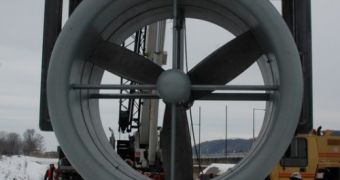Everyone knows that hydroelectricity can only be obtained via the use of hard-to-build and expensive water dams, which create a lot of nuisance around them, in that people need to be evacuated from their basins, and the threat of them breaking always hangs over the heads of those living downstream. However, now, near the town of Hastings, Minnesota, the United States' first underwater turbine has been installed, a construction that simply uses the force of the underwater currents for generating current, and does not require dams to operate.
The new propeller has the ability to produce some 35 kilowatts of power, and will soon be joined by a second one that will produce about the same amount of electricity. Together, these turbines will increase the output of an upstream hydroelectric power plant by 5 percent. Moreover, although the figures may not seem like much now, keep in mind that these machines are built to operate in large numbers, and a simple calculus may show us that 400 of them can yield the same amount of current as the dam itself.
The main advantage that these turbines have is that they can also operate independently, in parts of the rivers where building a dam is impossible. Creating a nationwide network of such devices could, one day, power up a large portion of the US power grid, with electricity produced from an alternative and totally green source.
“We don't require that massive dam construction, we're just using the natural flow of the stream. It's underwater windpower, if you will, but we have 840 or 850 times the energy density of wind,” Mark Stover, who is the vice president of Hydro Green Energy, the Houston-based company that was in charge of the new project, explains.
“I am thrilled to support today's historic order that allows for harnessing more power from the Mississippi River. I hope this is the first of thousands of similar projects that produce clean and renewable power from in-stream flows at existing dams,” Philip Moeller, a commissioner for the Federal Energy Regulatory Commission, adds in a press release.

 14 DAY TRIAL //
14 DAY TRIAL //